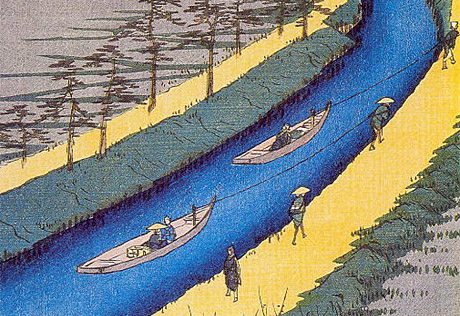Catagories and Cataloguing
29 January 2007
By Michelle Damian

First, I'd like to thank everyone who read my introductory entry and especially those who took the time to send words of encouragement or research suggestions. Many have been immensely helpful, bringing works to my attention that I didn't know existed and providing some wonderful information. The power of the internet can be a fantastic thing! I very much appreciate everyone's input, and look forward to any other comments, questions, or suggestions.
I mentioned in my introduction that I would be spending more time in the library than in the field. I’d like to revise that statement: the past two weeks I’ve spent more time bent over a scanner than anywhere else. The initial step in my project is to create a catalog of woodblock prints depicting vessels of all sizes. I have a number of books on woodblock prints, and have spent some time with a stack of sticky notes, flipping pages and flagging each and every image depicting boats. Some are incredibly detailed; some are simply a white square representing a sail on the horizon. All of them show something about how these vessels were made and used. So far I have flagged close to two hundred images with varying degrees of detail. I’m scanning them all in to be able to print them out individually and shuffle them around.

Top Image: Ejiri from Fifty-three Stages of the Tokaido by Ando Hiroshige.
Bottom Image From: Illustrated Book of Both Banks of the Sumida Rivers at a Glance by Katsushika Hokusai.
So now that I have them… what do I do with them? My thesis will focus on questions of vessel type, construction, and use, including an examination of the different kinds of vessels prevalent in certain areas (river, lake, canal, or other body of water). I am limiting the study to inland craft for now to keep the collection to a manageable size. I’d like to try to categorize the images in some way to denote type: pleasure vessels, working craft, ceremonial craft, or other styles, and see if construction details differ. Interestingly, Dr. Fred Hocker (Director of Vasa Research, Statens maritima museer, Stockholm) was a guest lecturer in one of my classes on material culture last week, and we all had a long discussion on categorizing artifacts. One thing I need to remember is that these categorizations are arbitrary designations imposed by me. While I separate by usage, someone else may differentiate by, say, propulsion method. Neither way is right or wrong, but they may not be how the shipwrights or artists would have seen their creations.
Soon my apartment floor will be covered with various piles of prints, this one for fishing vessels, that one for pleasure vessels, and so on. There will then be subdivisions - fishing boats that show the stern section clearly, ceremonial boats with stemposts, prints that don't have clear construction details but show the interplay of people and boats together. Hiroshige's Tow-boats on the Yotsugi-dori Canal is a wonderful example of this last: there are few construction details visible, but it shows both the pleasure-seekers out for a ride along the canals and the laborers towing them alongside.

Close up Detail from Tow-boats on the Yotsugi-dori Canal by Ando Hiroshige.
It's not all just about the prints, either. In the meantime I'm also trying to learn more about Japanese society in the late 18th and early 19th century, reading about the daily lives of the people and the role of this kind of artwork in that society. Since I've not yet been able to actually examine a vessel itself (though hopefully I'll get that chance in Japan) but am looking at representations of boats, I am a step removed and must keep issues of artistic license in mind.
So I will keep categorizing and organizing, try to make some determinations about construction styles and vessel uses, and prepare a long list of questions for the shipwrights and museums in Japan!
Please feel free to contact me at muaprojectjournal@yahoo.com with any comments, questions, or suggestions during the weeks to come. Yoroshiku onegai shimasu (“I look forward to your good favor”).
Return to Project Journal home page.

